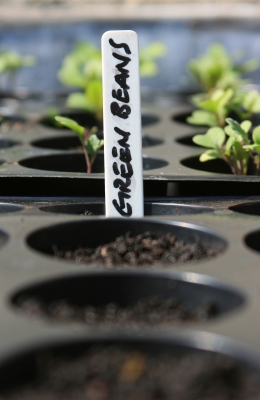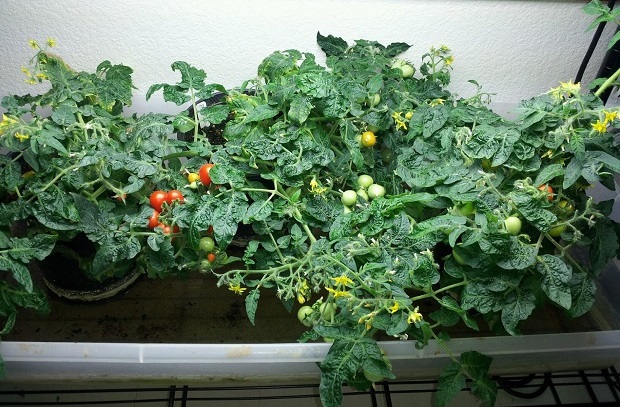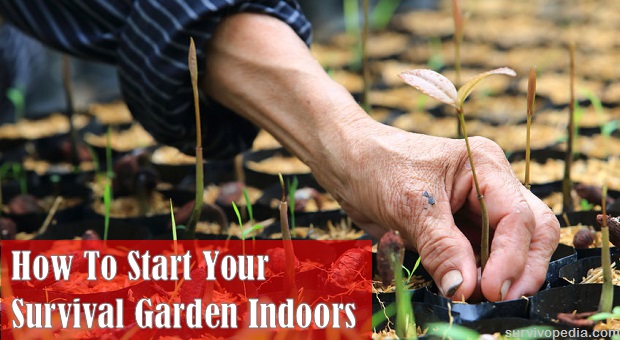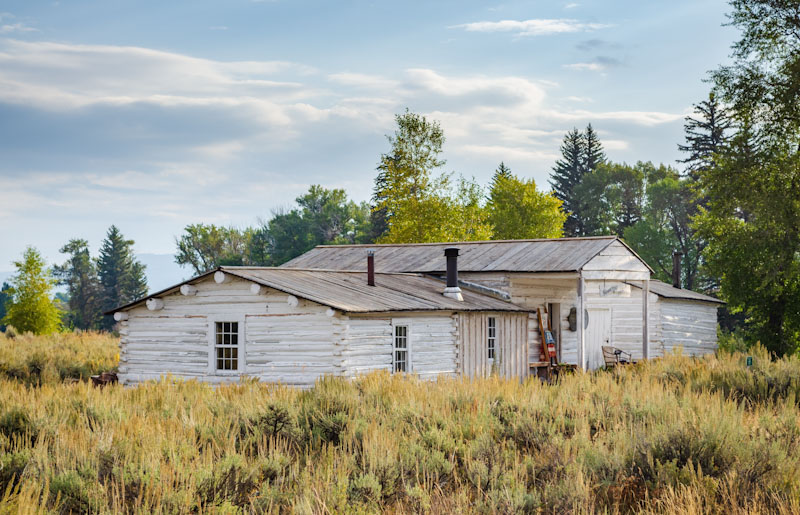Even though you may be planning to have your survival garden mature outdoors, it will be necessary to start some plants indoors. This is especially important to consider if you are going to make use of plants that have longer growing seasons, or ones that require special care.
Depending on where you live, some plants may need to be started indoors if you are going to get enough nutrients to live on from your garden.
Best Container Types
Perhaps it can best be said that seeds will sprout in just about any kind of container. On the other side of the equation, advancing from seedling to second leaves can be a difficult process.
For example, if you use seed starter mix in containers with poor drainage, the plants will develop large, weak stems, and then die. In a similar way, containers that are too small can lead to root-bound plans as well as ones with stunted growth. Today, most gardeners prefer 1.5 inch peat pots or pellets with one seed sown per pot or pellet.
When to Plant
As with regular gardens, each plant type requires different temperatures. Depending on where you live, most crops can be started in early spring. That said, if you live in the south, some plants may need to be started as early as February. Here are 6 plants commonly used by survival gardeners and information on how and when to start them for optimal success.
Bell Pepper
Water Needs: Moist with good drainage.
Lighting: Full sunlight.
Optimal Temperature: Bell peppers require at least 70 degree temperatures to germinate. If they have flowers, the temperature should not go above 75 degrees or the flowers will fall off without making fruit.
Best Soil: Neutral pH with good organic content.
When to Transplant Outdoors: It is best to transplant bell peppers when soil temperatures will not go below 65 degrees. It is also important to harden peppers off before transplanting, as the roots get disturbed easily.
Special Notes: To help lower temperatures during the flowering stage, use removable shade canopies, straw mulch, and chilled water. Placing two pepper plants close to each other can also enable both plants to receive shade from each other.
Bush Beans
 Water Needs: Moist soil, water near roots so that leaves do not remain wet for extended periods of time.
Water Needs: Moist soil, water near roots so that leaves do not remain wet for extended periods of time.
Lighting: Full sunlight.
Optimal Temperature: Bush beans prefer slightly cooler temperatures, but can also do well in mid to late summer. They should not be sown after soil temperature rises above 60 degrees.
Best Soil: Limited organic content, but soil should not be sandy. Excessive use of nitrogen in ground fertilizer will lead to reduced bean development. Since bush beans are legumes, they take in nitrogen through the leaves as opposed to the roots.
When to Transplant Outdoors: It is usually best to plant bush beans directly outdoors since their roots are easily disturbed. If you must start bush beans indoors, be sure to use peat pellets or peat pots that prevent loss of nitrogen fixing bacteria attached to the root systems.
Cabbage
Water Needs: Moist with good drainage.
Lighting: At least 6 hours of full sunlight.
Optimal Temperature: Prefers cooler temperatures. You should start cabbage plants either six weeks before the last frost in your area, or about 8 weeks before the first frost in the fall.
Best Soil: Cabbage requires soil with high organic content and a slightly acidic pH (below 7.0).
When to Transplant Outdoors: It is best to transplant cabbage outdoors within two weeks of the appearance of second leaves. If it is still too cold out, you can use black plastic or cold frames to protect the plants. Unfortunately, if cabbage plants become stunted at this stage, they will never pick up the growth tempo later on.
Carrots
Water Needs: Moist with good drainage.
Lighting: Carrots require full sunlight, but can tolerate some shade.
Optimal Temperature: Tend to be cool weather crops. You can start planting carrots about 2 weeks before the last frost and continue through spring.
Best Soil: Requires soft soil with a slightly acidic pH. It is best to avoid nitrogen-based fertilizers.
When to Transplant Outdoors: You can transplant outdoors as soon as first true leaves appear. If temperatures are still on the cold side, you can use cold frames or black plastic to keep plants warm.
Video first seen on Shakti Goddess 1.
Fennel
Water Needs: Moisture but not water logged. Needs good drainage.
Lighting: Requires full sunlight.
Optimal Temperature: In most areas, fennel is a perennial that can withstand freezing temperatures as well as summer highs.
Best Soil: Slightly sandy with good organic content.
When to Transplant Outdoors: Fennel usually doesn’t do well indoors, nor does it transplant well. That being said, if you start fennel indoors, you should transplant once the second or third set of full leaves appear. You can use peat pots or pellets to minimize transplant shock. It will also help to bring the plants outdoors for an increasing number of hours each day.
Garlic
Water Needs: Moist, but may require more water during bulb production.
Lighting: Full sunlight.
Optimal Temperature: Garlic can be started 2 – 4 weeks before the last frost in your area. Since it is a perennial, you can also plant in the late fall and look for shoots in the spring. Just be sure to cover garlic with straw or mulch in cold areas.
Best Soil: Loamy and well drained.
When to Transplant Outdoors: Since garlic is not usually started from seed, the bulbs are best planted outdoors. That said, garlic lends itself well to vertical container planting as long as the soil is loose and well-drained.
Onions
Water Needs: Moist, with well drained soil.
Lighting: Requires 14+ hours of full sunlight each day regardless of whether you are starting with seeds or sets.
Optimal Temperature: Start onion seeds at least 6 weeks before last frost date. Sets can be started 2 weeks before last frost, or planted directly in cold frames at this time.
Best Soil: Onions require soil rich in nitrogen. It should also be loose and drain well.
When to Transplant Outdoors: Overall, onions do not transplant well from indoor to outdoor settings. You can decrease transplant shock by exposing plants to outdoor conditions for an increasing number of hours each day. Similar to garlic, onions do very well in vertical containers and can be kept indoors for the full growth cycle.
Additional Notes: Since bulb growth is dependent upon the number of light hours, select “long day” onions if you live in the north, and “short day” for southern gardens.
Radishes
Water Needs: Moist, well drained soil.
Lighting: Requires full lighting. It is also important to keep radishes from being shaded by other plants. If radishes are planted too close to other crops, they will produce more leaves in order to compete instead of form roots.
Optimal Temperature: Radishes should be planted as soon as possible after the last frost. You can start new seeds until 6 weeks after the last frost in order to extend the harvest. Radishes can also be planted in the fall about 4 weeks before the first frost.
Best Soil: Prefers soft soil with good organic content.
When to Transplant Outdoors: It is usually best to start radishes outdoors, although they can be grown in large pots. If you need to start radishes indoors, use peat pots or pellets in order to reduce root shock.
Sweet Peas
Water Needs: Damp with good drainage.
Lighting: Full sun.
Optimal Temperature: Prefers cooler temperatures associated with early spring and fall.
Best Soil: Sweet peas prefer soil with low organic content. You can use straw and other organic mulch to keep shallow root systems moist and cool.
When to Transplant Outdoors: As with other legumes, Sweet Peas do best when planted directly into the garden. You can try using peat pots or pellets, and then harden them off gradually if needed.
Tomatoes
Water Needs: Moist with good drainage.
Lighting: At least 8 hours of full sun each day.
Optimal Temperature: Start seeds about 4 weeks before last frost. They can be set outside once three or four sets have grown.

Best Soil: Slightly acidic with high organic content. Starting compounds with slow release fertilizers tend to work better for advancing from seedling to plant stages.
When to Transplant Outdoors: You can transplant tomatoes as soon as all danger of frost is past. In order to spur growth, bury stem up to first set of leaves so roots can develop on it.
Many people interested in survival gardening realize that indoor gardening may be required to start crops that are usually planted outdoors. As long as you choose a container and soil that allows for easy transplant, it should be possible to achieve this goal, as well as keep plants indoors for the entire season if needed.
Needless to say, you can take advantage of both growth environments; it will maximize survival potential in any situation.
Zucchini
Water Needs: Moist soil with increased water once flowers and fruit begins to develop.
Lighting: Full lighting.
Optimal Temperature: Zucchini plants prefer temperatures in the 65 to 80 degree range. You can keep soil cool with straw mulch and removable shading tents.
Best Soil: Well drained soil with good organic content. Zucchini also usually requires additional fertilization later in the season for optimal production.
When to Transplant Outdoors: It is best to transplant zucchini outdoors when soil temperatures do not go below 65 degrees.









Pingback:How To Start Your Survival Garden Indoors | Survivalist Basics | Be Prepared For Anything! | October 23, 2014
|
Klas Persson | October 25, 2014
|
whether civilisation persists or perishes we are eating the wrong stuff. Most commonly known ‘vegetables’ are hybrids, difficult to grow, needs lots of water, proper soil, pesticides and attention. Myself I moved from Scandinavia to the rich soil of Turkey to study endemic edible and medicinal plants. My conclusion is that anyone could be selfsustainable on 500 m2 land, just the right plants have been taken off the menu.
Here are a few examples of plants, edible, either perennials or invasive, that can easily be introduced to any smallscale garden, and thrive:
amaranthus hypochondriachus (although needs hot climate)
urtica dioica (invasive from temperate to subtropical if grown in nitrogen)
viola odorata
bellis perennis
taraxacum officinale
tropaeolum majus
cichorium intybus
borago officinalis
ipomoea batatas
aegopodium podagraria (invasive in temperate climate)
portulaca oleracea (invasive in subtropical climate)
epilobium angustifolium (invasive in temperate climate)
astragalus and saltbush interesting too but haven’t done proper research.
But my conclusion is, for a survival situation you’d want an evergreen shrub with edible leaves. Horizonherbs got a few tips for the future covering US climate, myself Im more mediterranean…
could do a more intense research if interest is shown.
Cheers from Turkey
Pingback:Shockingly Delicious Survival Food | Survival skills, survival guns, survival guide | November 5, 2014
|
Pingback:Rotating Crops When Planning Your Next Year Garden | Survival skills, survival guns, survival guide | November 12, 2014
|
Pingback:8 DIY Survival Projects Out Of Plastic Bottles | Survival skills, survival guns, survival guide | December 12, 2014
|
Pingback:8 DIY Survival Projects Out Of Plastic Bottles | The Prepper Dome | December 12, 2014
|
Pingback:Surviving Societal Collapse | Survival skills, survival guns, survival guide | January 7, 2015
|
Pingback:Growing Food In Different Climate Zones | Survival skills, survival guns, survival guide | January 8, 2015
|
Pingback:Self Sufficient Greenhouse Gardening | Survival skills, survival guns, survival guide | January 13, 2015
|
Pingback:Why You Need These 5 Basic Bushcraft Tools | Survival skills, survival guns, survival guide | February 25, 2015
|
Pingback:4 Edible Plants To Grow Indoors | Survival skills, survival guns, survival guide | May 5, 2015
|
Pingback:How To Grow Peppers Indoors | Survival skills, survival guns, survival guide | June 14, 2015
|
Pingback:How To Grow and Preserve Peppersdisasterdefense.usdisasterdefense.us | disasterdefense.us | June 14, 2015
|
Pingback:How To Grow and Preserve Peppers | The Prepper Dome | June 17, 2015
|
Pingback:How To Grow and Preserve Peppers | June 17, 2015
|
Pingback:Growing Food In Different Climate Zones | July 28, 2015
|
Pingback:Rotating Crops For Your Next Year Garden | August 27, 2015
|
Pingback:4 Edible Plants To Grow Indoors | September 23, 2015
|
Pingback:The Survival Garden: Fundamentals – The Prepper Dome | December 16, 2015
|
Pingback:20 Early Spring Edibles: How and When to Grow Them | Survivopedia | February 29, 2016
|
Pingback:Survival Garden: DIY Cold Frames | | Disasterdefense.us | March 7, 2016
|
Pingback:Shockingly Delicious Survival Food - US Crisis PreppersUS Crisis Preppers | April 11, 2016
|
Pingback:Survival Gardening: What Grows Where | Survivopedia | June 1, 2016
|
Pingback:Survival Gardening: What Grows Where | | disasterdefense.us | June 1, 2016
|
Pingback:Survival Gardening: What Grows Where | Prepper's Survival Homestead | June 2, 2016
|
Pingback:The Survival Garden: Fundamentals | Survivopedia | June 13, 2016
|
Pingback:The Survival Garden: Fundamentals – Prepper Ways | June 24, 2016
|
Pingback:Why You Can't Grow Food In Containers | Survivopedia | February 12, 2018
|
Pingback:6 Tested Tips For Your Self-Sustaining Garden | Survivopedia | May 30, 2019
|